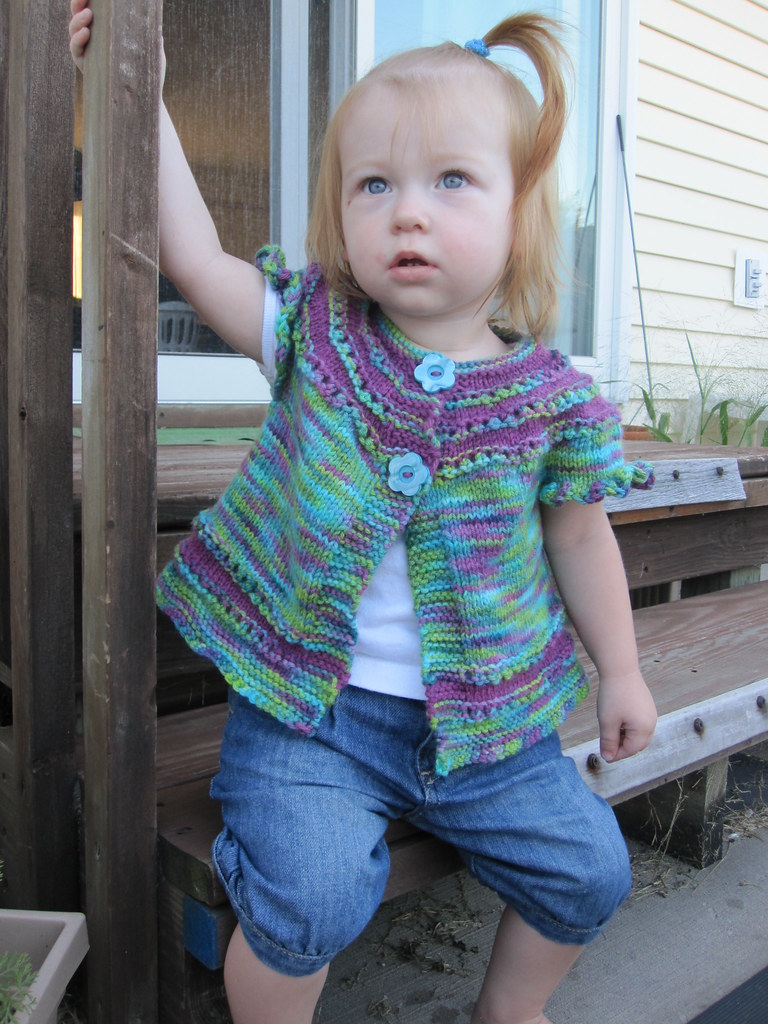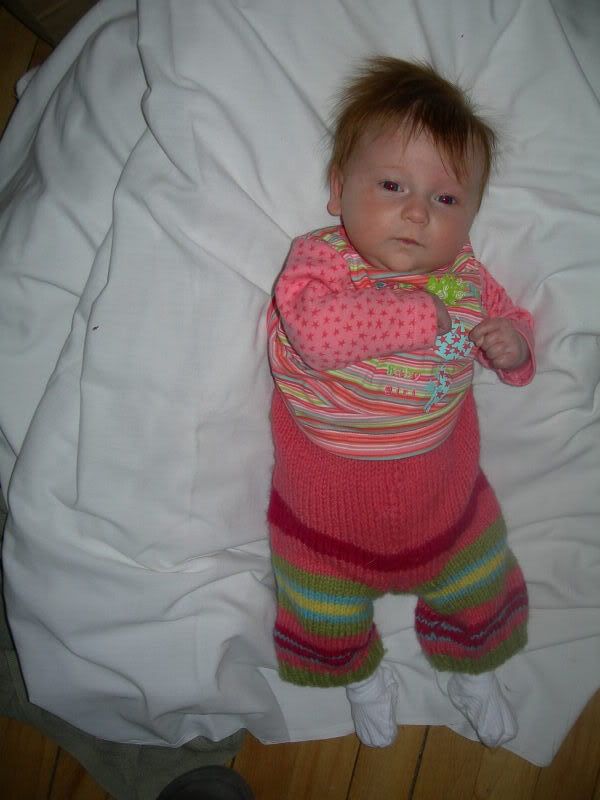Let's start with the "they'll destroy it" argument. My children have actually never ruined a wool garment. Never. Granted, I'm conscious of their activities and change them into scrubby clothes when needed, but even with near-daily use, they've never destroyed anything I've knit for them. I have destroyed a few pairs through pure laundry stupidity, but the kids haven't. Yes, I've had to sew up a hole where the carseat buckle got stuck on the yarn and Daddy pulled a bit too hard to get the child loose, and sure, kids get grubby here and there, usually on the knees or butt. However, as long as I keep food, paint, and mud away from the woolies, we're good for whatever the day throws at us.
In fact, I have many pairs of longies that both of my children wore. Here, for example, are both girls in a pair of longies made from an old sweater. You'll want to notice that while my first daughter is only 2 months old when wearing this pair of longies, my second daughter is 8 months old.
Now, the "they'll outgrow it" argument against wool for children. Let's look first at wool pants, or longies, as they're called. You'd be surprised to learn that when you cloth diaper a child, their hip circumference and rise measurements don't change as much from early infancy through toddlerhood as you might think. In the early months, the all-liquid diet of an infant ensures that your diapers will be bulked up enough to fill an 18-19" hip measurement with only a little slack. By the time your child is potty-training, you'll find that their hip measurement, over those training pants, is STILL 18-19"! So the longies your young infant wore as pants the winter they were born:
Are still going to fit them as a toddler, 2 years later.
Sure, your child may be a summer baby and a winter toddler, but there will me multiseason overlap in their wardrobe if you invest in some capris or longies.
 As for sweaters and multiseasonal use, you may be surprised to find that my 2 year old, who wears a size 2T, has a 20" chest where my 4 year old, who wears a size 5T, has a 21" chest. Here is the same sweater on both girls, who at the time of the pictures, were wore size 5T and 18 mos, respectively.
As for sweaters and multiseasonal use, you may be surprised to find that my 2 year old, who wears a size 2T, has a 20" chest where my 4 year old, who wears a size 5T, has a 21" chest. Here is the same sweater on both girls, who at the time of the pictures, were wore size 5T and 18 mos, respectively.  So if I knit up a short-sleeve, or sleeveless sweater, such as in my previous post, I can count on my duaghter to fit into it for at least 2 winters, maybe even three! The biggest difference is the length from neck to waist. In this case, the sweater can be knit long for the toddler and be just a tad short for the pre-schooler, OR I can be smart, save the leftover yarn, and simply undo the hem and knit on a few extra inches when the growth spurts come! Three seasons of wear for only $30 in yarn is NOT bad! And if you remember from my last post, that $30 of yarn actually provided enough yardage for TWO Ivyanna sweaters, so that's two children and 2-3 seasons per sweater, all for $30. This does assume, however, that I knit it myself and not pay someone else to knit it.
So if I knit up a short-sleeve, or sleeveless sweater, such as in my previous post, I can count on my duaghter to fit into it for at least 2 winters, maybe even three! The biggest difference is the length from neck to waist. In this case, the sweater can be knit long for the toddler and be just a tad short for the pre-schooler, OR I can be smart, save the leftover yarn, and simply undo the hem and knit on a few extra inches when the growth spurts come! Three seasons of wear for only $30 in yarn is NOT bad! And if you remember from my last post, that $30 of yarn actually provided enough yardage for TWO Ivyanna sweaters, so that's two children and 2-3 seasons per sweater, all for $30. This does assume, however, that I knit it myself and not pay someone else to knit it. Personally, I knit, so my only investment in woolen garments for my children is the yarn and my time. If I look at really cheap yarn, the stuff that's only $6 for 4oz at your local craft store, you can make a pair of medium-sized longies for only $8 worth of yarn. A lot of people don't like cheap yarns, but personally, the fact that they felt in the crotch and bum never bothered me since it adds to the ability of the garment to contain diaper blow-outs. Cheap yarn isn't as soft and it often pills more than expensive yarns. I have found, though, that after a few rounds of washing and lanolizing, even cheap wool feels pretty nice on the skin. And as for pilling, I own a sweater shaver and for the once or twice a month that I have to use it, I actually find I enjoy the process. The kids even fight over the honor of being allowed to run the sweater shaver.
That doesn't mean that I don't have many woolen garments for my children that are made from expensive yarns. I do. For the most common expensive yarns used in children's clothing, it would cost me about $30-60 for the yarn for the garment. "Yikes!" you say. But let's remember that the child will wear the longies for up to 3 years. The yearly cost of that item is now $10-20. My child has non-woolen garments that cost me that much per season's use. Also remember that longies, shorties, capris, and skirties will double as diaper covers during the first two years (or more!) of your child's life. This means that one pair of $30 longies can replace 3 diaper covers which would have cost me $45.
And let's not forget resale value! Used woolen garments can often be resold online to other cloth-diapering families. Often, you'll find that you can resell the used garments for at least the cost of your yarn. So, in the end, a pair of longies that may have cost me $30 in yarn to knit, will save me $15 in diaper cover cost, and sell for $30 when I'm done with them. Essentially, the longies have just paid me $15 to use them for 3 years. Do you have any other clothing items that PAY YOU to use them? I don't!
The final component to why I would encourage you to use woolen garments on your children is the "easily recycled" nature of wool yarn. I can knit a pair of longies for my daughter, have her wear them for 3 years, and then simply take them apart, wash the yarn, and knit her something new! Maybe I'll knit her a hat and mitten set, maybe a sweater vest, maybe a pair of slippers... the possibilities are endless. Fro example, my youngest daughter has in her wardrobe a pair of longies that she wore from late winter to early summer last year and will wear again from fall to spring this year. I have been eying the yarn in those pants with a great deal of longing since they arrived nearly 9 months ago, just waiting for her to outgrow them so that I can have a new winter hat and mitten set!




1 comment:
I really loved reading these last two posts. I often forget how this works. DS is wearing a pair of interlock woolies I paid $10 for on spots before he was born. He's worn them for 18 months now and there is still enough stretch in the waist to probably wear them again next summer.
Thanks =)
Post a Comment